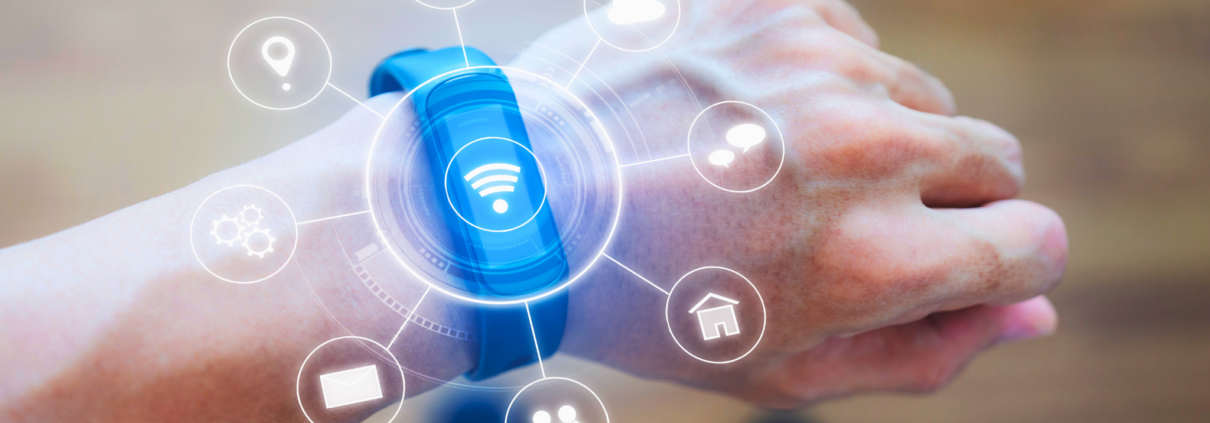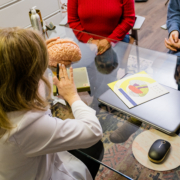Making sense of sensors to help older adults
When 93-year-old Thelma Post (played by the feisty June Squibb) deliberately removes her tracking bracelet in Thelma, this summer’s blockbuster movie, her grandson patiently asks her to keep it on her wrist—for his mental health.
This wear-it-or-not sensor subplot was compelling for the issue it raises for the wearer and her loved ones, but also because it shows how far we’ve come since the days of the “I’ve fallen and can’t get up” commercials for LIFE ALERT, which were scary reminders of how important it was for older family members to wear the call-for-help button around their neck.
There are sensors for just about everything these days, but these iterations are wearable or in-home devices designed to monitor critical patient information. As the tools continue being refined, there’s also been an explosion of products in this category, including the development of soft toy robots that will not only be a plaything but also keep the cognitively impaired person safe.
“These will come with embedded wearables to help care for dementia and Alzheimer’s patients,” says Jyoti Mishra, associate professor of psychiatry at the University of California San Diego. Mishra the founder of the Neural Engineering & Translation Labs at UCSD, is consulting with MaXentric, the San Diego-based company that is developing the product.
Several peer-reviewed articles (like this one and this one) have been written in the last few years about how sensors are helping older adults who are experiencing cognitive impairment. Many experts say this is only the beginning of how sensors can help people as they age.
“There’s so much technology available now, whether it’s smart cameras, motion cameras, or wearables,” says Laurie Orlov, founder of Aging and Health Technology Watch, a market research firm that provides thought leadership about technologies that enable older adults to remain longer in their homes. “They’re now smaller and less expensive than they once were—we can definitely say they’re going through a reincarnation.”
And since 88 percent of people want to age in place in their homes , according to a University of Michigan study, sensors will continue to serve an important and potentially life-saving role.
“These [sensors] serve many functions, including helping to detect if someone has gotten up and gone to the bathroom or gone to the kitchen,” Orlov says. “These can give family members a positive check-in, for them to feel like their mom is okay, and they can also detect if she has fallen or has left the house and is now wandering in the neighborhood.”
(It’s worth noting that these devices aren’t all specifically designed just for monitoring; capabilities to detect hard falls and other physically traumatic events are now being added into nearly ubiquitous devices such as smartphones, smart watches, and so on.)
Ultimately, this explosion of sensor technology can only be thought of as an improvement to lifeline draw-pulls in, say, the bathrooms of every senior-living home.
“We’ve always had emergency alert technology for people who have to be alone and are at risk, but these new options have the potential to be way more helpful for someone with a cognitive impairment,” says William Dale, City of Hope’s chair of Supportive Care Medicine and the director of the Center for Cancer and Aging in Duarte, California. “The ability to monitor, say, the doors or windows in a home can be especially helpful for families that are already stretched thin by the cost of round-the-clock care. I like that we have these options.”
Here are a few places where sensors are being used to help individuals with cognitive issues:
In cars
Driving is demanding enough for most people. If an individual has cognitive impairments, driving may be even more challenging. Middle-aged people are deploying Life360 and other tracking apps on their parents’ phones as a way to keep tabs on them when they drive. And, while there are an increased number of options for technology taking over in risky situations—warning sensors, car takeover in urgent situations which may become more “standard” in the automobile industry over time—there are some big concerns when it comes to allowing people with cognitive impairments to drive, says Maria T. Schultheis, vice provost of research and a professor in the department of Brain and Psychological Sciences at Drexel University.
Schultheis is studying this exact issue. While she noted that these technologies can help keep people safe, she warned there is a danger associated with them as well.
“Something that may not be appreciated is that ‘too many’ technologies in the vehicle may work against cognitive support,” she says. “That is, they may be more distracting or challenging and therefore, consideration for how we select these technologies and how we train for the use of these technologies is important in general, but especially for a population that may be cognitive compromised.”
In memory care settings
At Maplewood Senior Living, which has 17 locations across five states and Washington, D.C., those residents living in memory care settings in New York City and Bethel, Connecticut, have been able to access AUGi, an AI-enabled fall prevention and safety system (billed as “the world’s first cognitive resident care assistant”) for the past 18 months.
“Before we started using this technology, we might not know if a resident—ours live in their own apartments because we value privacy and want them to be as independent as possible—has fallen until we do our regular rounds,” said Brian Geyser, Maplewood’s vice president of health and wellness. “We can now respond in under one minute if something does happen.”
The AUGi device is a sensor mounted in patients’ rooms that uses AI to monitor safety events in the room. It watches patients’ movements to suggest that they might be exiting their bed or their chair. The images are de-identified to protect patient privacy and comply with regulations; if the sensor determines that the patient needs assistance, it automatically notifies nursing staff to get involved.
In smart apartments
At Washington State University, Maureen Schmitter-Edgecombe, a professor of psychology, has been an innovator in the development of “smart” apartments, which contain movement sensors to keep a watchful eye on an individual’s activities. In the spirit of AUGi, these apartments also feature warning sensors, fall detectors, floor sensors and a computer program that reminds residents to, for example, turn off the stove or take their medications.
In bedding
Analyzing a person’s sleep habits doesn’t necessarily require the person to wear a device on his or her wrist. Instead, a smart sleep pad (in this case, a pressure sensitive mat) that is placed under the mattress might suffice. “It can track heart rate, sleep patterns, sleep apnea and a multitude number of other things that we can alert family members about,” says Ryan McEniff, president of WellAware Care, a passive patient monitoring company in Littleton, Massachusetts, that uses ambient technology to allow seniors to age in place—and skip the wearables. This can also save a family round-the-clock care. “We had a resident who would get up to use the bathroom and because of her memory impairment, would forget to use the call button and, inevitably, she would fall. With the smart bed pad, the second she got out of bed, the aides could come in and help her get to the bathroom safely.”
In the restroom
Since urinary tract infections (UTIs) are one of the most common health issues for older adults (and can be the most deadly if they lead to sepsis), the development of the U-Scan, made by Withings, a health technology company in France, will be a game-changer, McEniff says. “It’s like a urinal cake inside the bowl,” he says of the 90-millimeter diameter device that provides a snapshot of the biomarkers in urine that are linked to a UTI. “When someone goes to the bathroom, the urine splashed on the device, can be read immediately.” Interventions flow from there. (See what we did there?)
In the refrigerator
Smart fridges will continue to play an important role as a home sensor as they feature calendar and clock functions to help orient individuals who may be confused about the day of the week or the season, says Leah Daly, education program manager at the Alzheimer’s Foundation of America. “These come with a tiny camera inside that, when connected to an app, can show you what’s inside of the fridge and help keep track of what someone is or isn’t eating or if they are or aren’t taking the medications that need to be refrigerated,” says Daly.
These fridges serve another vital role: “Most come with a screen on the door where you can upload photos and reminiscent memories,” Daly says. “This is important for people with Alzheimer’s. Having these reminders can improve a person’s mood and improve their cognition, too.”
In the end, no matter how advanced sensor technology gets, you still need someone to keep an eye on what the data is showing, Orlov says.
“You need to have someone in the person’s life who is motivated to monitor the sensors,” Orlov says. “You also need someone else, such as a physician or home care worker, who can analyze the data because, when data is aggregated together, it can produce a worrisome trend, such as a lot more trips to the bathroom, slower walking or perhaps a trend towards the person becoming more of a fall risk.”
After all, once a person’s needs increase beyond the range of any sensor, only a loving human, not a piece of technology, will be able to step in and do the work to make a loved one feel safe.
This article has been factchecked. For more about that process, click here.









